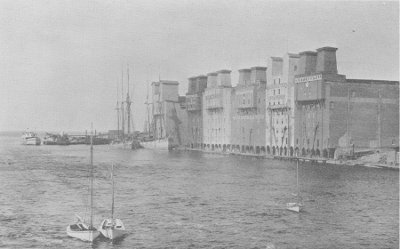Gerrit Smith of Peterboro, New York, was probably the largest individual financial contributor to the anti-slavery campaign in the years prior to the Civil War. In addition, he was the leading contributor to the armed militant operations of anti-slavery zealot John Brown prior to the invasion of Harpers Ferry, Virginia. He was one of a small group of men called "The Secret Six" that supported John Brown's armed crusade.
Few historians have looked for any cause for his actions beyond a simple belief in the man's superior humanitarian feelings and Christian philosophy. However, Smith had some very strong financial reasons to work to diminish southern power in the national Congress. Understanding these financial interests is an absolute prerequisite to understanding the mental terror that drove Smith to his various anti-slavery activities.
Smith was the owner of the "Great Wharves" in the harbor at Oswego, New York. Although Smith was New York State's largest landowner, the facilities at Oswego provided most of his income. His investments there drove him to ask of the federal government certain benefits that the free market would not give. With the South in political control of the government, however, he could not get what he wanted. These benefits included appropriations of federal money for harbor improvements that would protect his wharves from lake storm damage.
Yet another expense of maintaining the harbor was the constant dredging required to maintain the proper depth of the channel in the river and harbor. Federal dredges usually did the work.
Another benefit he sought was a policy of the federal government to give away parcels of its western lands, free of charge, to actual settlers in the West. Oswego is the nearest point on the Great Lakes to New York City. Settlers to the West would travel from New York City up the Hudson River, west on the Erie Canal to Syracuse, North to Lake Ontario on the Oswego Canal, then, embarking at Gerrit Smith's wharves, west on lake schooners or steamers to the various ultimate destinations in the western lands. The traffic across Smith's wharves generated docking fee income for Smith. A policy of free land in the West would greatly increase the stream of settlers and, consequently, Smith's income.
The South, however, objected to the free-land-in-the-West policy because the loss of revenue from the sales of land would have to be made up by increases in the tariff which would then reduce southern agricultural revenue. Moreover, the free land policy would tend to build up the North faster than the South, hastening the day when the South would sink in the federal power balance, leaving it vulnerable to rapacious tariff legislation which would certainly come.
Settlers in the West raised grain which they shipped back to eastern markets on Great Lakes schooners many of which would tie up at the grain elevator at the harbor. Gerrit Smith's grain mill, along with others, ground the wheat into flour which was shipped down the Oswego Canal, the Erie Canal to the Hudson and New York City. There was at Oswego an enormous capacity to make and ship flour.

The picture shows the rows of grain elevators on the bank of the Oswego River at the harbor. It was taken about 1890.
Gerrit Smith had a financial interest in the water power utility on the east side of the river that provided the force to turn the grinding wheels in the mill. At one time Smith owned ninety-three percent of the water power utility.
In addition, Smith had other properties in town that would benefit from increased traffic of westbound settlers.
The South, however, objected to expenditures on northern harbors. The funds must necessarily come from the tariff, ultimately diminishing southern cotton revenue by a multiple. When the South was in political control, funds for internal improvements did not flow freely. When Congress passed the Rivers and Harbors Bill in 1846, President James K. Polk of Tennessee vetoed the bill. Outraged northerners with an interest in internal improvements met in a great Rivers and Harbors convention in Chicago in 1847 and vowed to work together to bring the federal government to open its purse strings.
Congressman-elect Abraham Lincoln attended as a delegate to the convention. His great speech there was said to have earned him admiring recognition from the delegates from other states. Edward Bates, the president of the convention, later became Lincoln's attorney general. Many of those in attendance ultimately became important personages in the Republican political party.
Gerrit Smith himself was elected to Congress in 1852 and served from 1853 to 1854 when he resigned. In 1854, he moved to add an additional $50,000 to the appropriation to the $21,000 already appropriated for the harbor at Oswego. He thought it was unjust that the federal government drew large customs revenue at the Oswego harbor, but did not maintain the harbor. He realized, however, that adding $50,000 to the bill might cause its rejection in which case Oswego would get nothing. He withdrew his amendment.
Gerrit Smith acquired his Oswego harbor land at an auction of federal government properties in 1827 and subsequently developed the property to better serve the business that was building.
A copy of an old map showing the Gerrit Smith wharf properties is here.
A panoramic view of the decayed great wharves in 1914 is here. In the bottom (right-hand view) the federal break wall can be seen in the distance. The vulnerability of Smith's Great Wharves to fierce lake storms, without sturdy sea walls, is obvious. Periodically, lake storms did serious damage to the sea walls, necessitating expensive repairs.
A modern satellite view of the harbor showing that the great wharves are filled in.
It was Gerrit Smith's financial desperation to get federal benefits and the constant thwarting of the desired appropriations by the South that drove Smith to join the anti-slavery crusade that was already under way by others.